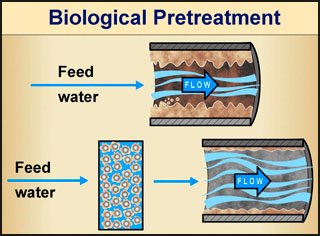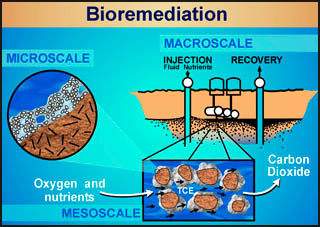A substantially updated version of the hypertextbook is available here. Please migrate to that version. This one will eventually disappear.
Objectives
The objectives of this section are
to provide you, on the one hand, with a few more detailed examples how biofilms can be used in beneficial ways;
to give you, on the other hand, a few more detailed examples of some of the harmful impacts of biofilms.
Outcomes
Upon completion of this section, you will be able
to discuss more detailed examples of both the beneficial and harmful impacts of biofilms on our world;
to describe in an informal way how the biofilm mechanism works to achieve either a beneficial or harmful effect, based on the situation in which the biofilm appears.
How do biofilms impact our world?
Biofilms profoundly affect human health and industrial productivity. Their pervasive effects on human health, water quality, corrosion, and power generation efficiency cost the U.S. billions of dollars annually. Other related issues include deterioration of dental surfaces, contamination of surfaces in the food processing industry, and the deterioration of air quality in ventilation and air handling systems.
However, it is very important to point out that biofilms are an integral part of the natural environment and can also serve very beneficial purposes, such as in the treatment of drinking water, wastewater and detoxification of hazardous waste.
Both the beneficial and detrimental aspects of biofilms are summarized below.
BENEFICIAL BIOFILMS
In natural environments
In bodies of water both large and small, on land, underground, as well as on and within higher organisms, biofilms are an integral component of the natural environment. The report, "Global Environmental Change: Microbial Contributions, Microbial Solutions," points out: ". . .the basic chemistry of Earth's surface is determined by biological activity, especially that of the many trillions of microbes in soil and water. Microbes make up the majority of the living biomass on Earth and, as such, have major roles in the recycling of elements vital to life." Bacteria and other microorganisms have also been associated with the formation of many types of sedimentary rocks and minerals.
Bacteria are early colonizers of clean surfaces submerged in water. Scientists have been able to document the predictable sequential colonization of surfaces in ocean waters by series of organisms, beginning with microbial biofilms. Whether the surface is a boat hull at the surface or a new deep sea vent at the bottom of the ocean, microbes are available and capable of rapid community development on surfaces. Microbes have evolved along with other organisms, including human beings. While some bacteria produce effects that are detrimental to surrounding organisms or hosts, most bacteria are harmless or even beneficial. When it comes to bacteria, higher organisms are just another environment to colonize.
Water and wastewater treatment

Engineers have taken advantage of natural biofilm environmental activity in developing water-cleaning systems. Biofilms have been used successfully in water and wastewater treatment for over a century. English engineers developed the first sand filter treatment methods for both water and wastewater treatment in the 1860s. In these filtration systems the surfaces of the filter media act as a support for microbial attachment and growth, resulting in a biofilm adapted to using the organic matter found in that particular water. The end result of biological filtration is a conversion of organic carbon in the water into bacterial biomass. Ideally, this biomass is immobilized on the filter media and removed during the backwash cycle.
Drinking water and treated wastewater that have been subjected to microbial activity in a controlled manner in a treatment plant are more "biologically stable" and therefore less likely to contribute to microbial proliferation downstream in distribution system or receiving water. Biologically treated water typically has lower disinfectant demand and disinfection by-product formation potential than conventionally treated water if the source water is high in organic carbon. As drinking water utilities move to using ozone as a primary disinfectant and for taste/odor/color control, biological filters may be necessary to reduce the concentrations of biodegradable organic carbon entering the distribution system.
Remediation of contaminated soil and groundwater

In soil, biofilm morphology can be highly variable, ranging from patchy discontinuous colonies to thick continuous films, depending on environmental conditions. When toxic organic contaminants (i.e. gasoline, fuel oil, chlorinated solvents) are accidentally released underground, the native soil bacterial population will, to the degree possible, adjust their ecological composition in order to use the organic contaminants as a food source. This process is commonly referred to as “bioremediation” and if successful, potentially has the ability to render initially toxic organic material into harmless by-products. Typical biofilm cell densities found in the vicinity of contaminated ground water sites vary from around 105 to 108 cells per gram of soil.
Bioremediation has emerged as a technology of choice for remediating groundwater and soil at many sites contaminated with hazardous wastes. Bioremediation results in 1) the reduction of both contaminant concentration and mass for many subsurface contaminants (e.g., petroleum hydrocarbons, chlorinated organics and nitroaromatics) and/or 2) a beneficial phase transfer or speciation change (e.g., for heavy metals and radionuclides). Subsurface bioremediation is controlled by abiotic geochemical and transport phenomena, including multiphase flow, convective mass transport, adsorption/desorption, and phase partitioning, as well as biotic processes, such as microbial biomass growth and contaminant metabolism
Microbial leaching
Extraction of copper from ore deposits using acid solutions has been practiced for centuries, but the role of bacteria in metal dissolution was not verified until the 1940s. Today approximately 10–20% of copper mined in the U.S. is extracted by microbially assisted processing of low grade ores. There is also a considerable investment in extending microbial leaching to the recovery of other metals such as uranium, silver, gold, cobalt, and molybdenum. Most microbial leaching depends upon microbial oxidation of metal sulfides. Aqueous environments in association with spent mineral produce very harsh conditions of low pH, high metal concentrations and high temperatures, which select for a microbial flora with very specialized nutritional requirements.
Heap leaching is the most common process used to microbially extract copper and other minerals from spent ore. The process consists of organizing the spent ore fragments into a packed bed configuration which allows water to be trickled through. To initiate the process, acidified water (pH = 1.5 to 3.0) is sprayed over the porous ore bed. Acidophilic bacteria, such as Thiobacillus ferrooxidans, actively oxidize the soluble ferrous iron and attack the sulfide minerals, releasing the soluble cupric ion that can then be recovered from aqueous solution. This oxidation process is similar in concept to corrosion of metal surfaces.
Biological reaction and mass transfer rates presently limit the commercial application of microbial leaching, however substantial improvements in process design have been made in recent years and the method is viewed with promise by the mining industry.
Other biofilm technologies with promise
- Microbial fuel cells
- Biofilm "traps"
- Microbial "canaries"
DETRIMENTAL BIOFILM IMPACTS
In natural environments
"Microbes can negatively impact environments on a global level including producing and consuming atmospheric gases that affect climate; mobilizing toxic elements such as mercury, arsenic and selenium; and producing toxic algal blooms and creating oxygen depletion zones in lakes, rivers and coastal environments (eutrophication). Furthermore, the incidence of microbial diseases such as plague, cholera, Lyme disease, and West Nile Virus are linked to global change."
In industrial environments
Biofouling, biocorrosion, equipment damage and product contamination are constant and expensive problems in industry, as graphically illustrated in the slide show in Section 2 of this module.
Public health
Between 1980 and 1992, infectious disease deaths increased by 58% (39% after age adjustment); the major contributors were HIV infection and AIDS, respiratory disease (primarily pneumonia), and bloodstream infection. Infectious diseases are still broadly endemic and maintain a large reservoir of agents that have the potential for rapid and widespread dissemination. Infectious diseases remain the leading cause of death worldwide and the third leading cause of death in the United States. In the United States, each year, approximately 25% of physician visits are attributable to infectious diseases, with direct and indirect costs estimated at more than $120 billion. Because recent research implicates biofilms as reservoirs for pathogenic organisms and sources of disease outbreaks, biotechnology measures are being created to control biofilms and/or sever the routes by which pathogenic organisms are transmitted from biofilms to susceptible people.
Biofilms are implicated in otitis media, the most common acute ear infection in children in the U.S. Other diseases in which biofilms play a role include bacterial endocarditis (infection of the inner surface of the heart and its valves), cystic fibrosis (a chronic disorder resulting in increased susceptibility to serious lung infection), and Legionnaire's disease (an acute respiratory infection resulting from the aspiration of clumps of Legionnella biofilms detached from air and water heating/cooling and distribution systems).
Biofilms may also be responsible for a wide variety of nosocomial (hospital-acquired) infections. Sources of biofilm-related infections can include the surfaces of catheters, medical implants, wound dressings, or other types of medical devices.
Biofilms avidly colonize many household surfaces, including toilets, sinks, countertops, and cutting boards in the kitchen and bath. Poor disinfection practices and ineffective cleaning products may increase the incidence of illnesses associated with pathogenic organisms in the household environment.


